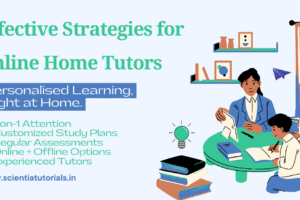Effective Tips for Home Tutors to Make Education Enjoyable and Stress-Free
Introduction
In today’s rapidly evolving educational landscape, home tutoring has emerged as a vital component of academic support for students. As a home tutor, the responsibility extends beyond merely imparting knowledge; it encompasses creating an engaging, supportive, and enjoyable learning environment that reduces stress for students. This article delves into effective teaching tips that can help home tutors foster a positive learning experience, ensuring that students not only grasp the concepts being taught but also enjoy the process of learning.
Understanding the Student’s Perspective
The Importance of Empathy
To effectively teach, home tutors must first understand their students’ perspectives. Every student comes with unique experiences, strengths, and challenges. Developing empathy allows tutors to connect with their students on a deeper level, making them feel valued and understood. This connection can significantly enhance a student’s motivation and willingness to learn.
Identifying Learning Styles
Recognizing that each student has a preferred learning style is essential. Some may be visual learners who benefit from diagrams and charts, while others may be auditory learners who grasp concepts better through discussion. Acknowledging these differences and adapting teaching methods accordingly can make learning more enjoyable and less intimidating.
Creating a Comfortable Learning Environment
Setting Up the Right Space
A conducive learning environment is crucial for effective tutoring. Ensure that the tutoring space is comfortable, well-lit, and free from distractions. A designated learning area helps signal to students that it’s time to focus, making the transition from home life to learning smoother.
Establishing a Routine
Establishing a consistent routine can provide students with a sense of security. Regular schedules help students know what to expect during tutoring sessions, reducing anxiety and stress. Incorporate breaks into the routine to allow students to recharge, making the learning process feel less overwhelming.
Incorporating Interactive Learning Techniques
Engaging Activities
Interactive learning techniques can significantly enhance students’ engagement and enjoyment. Incorporate games, quizzes, and hands-on activities relevant to the subject matter. For example, using educational board games for math or science can make complex concepts more accessible and fun.
Utilizing Technology
Incorporating technology into tutoring sessions can add an exciting dimension to learning. Use educational apps, videos, and interactive websites to supplement lessons. For instance, platforms like Khan Academy or Quizlet can provide students with additional resources that cater to their individual learning styles.
Collaborative Learning
Encourage students to work together on projects or study groups. Collaborative learning fosters a sense of community and can reduce the pressure students feel when learning challenging material alone. Additionally, discussing ideas with peers can enhance understanding and retention of information.
Making Learning Relevant and Relatable
Connecting Concepts to Real Life
One of the most effective ways to make learning enjoyable is to relate academic concepts to real-life situations. For instance, when teaching mathematics, use examples from everyday life, such as budgeting or cooking, to demonstrate the relevance of math skills. This approach not only makes learning more relatable but also helps students understand the practical applications of their studies.
Encouraging Student Interests
Integrate students’ interests into lessons whenever possible. If a student is passionate about a particular subject, find ways to incorporate that into your teaching. For example, if a student loves sports, use sports statistics to teach math concepts. This personalization can spark excitement for learning and make sessions feel more engaging.
Building Confidence Through Positive Reinforcement
Celebrate Achievements
Recognizing and celebrating students’ achievements, no matter how small, can boost their confidence and motivation. Create a reward system that acknowledges milestones, such as completing a challenging topic or improving test scores. Simple praise or a small reward can go a long way in reinforcing positive behaviors and encouraging continued effort.
Provide Constructive Feedback
When students struggle with a topic, it’s essential to provide constructive feedback that emphasizes improvement rather than failure. Frame challenges as opportunities for growth, helping students to view setbacks as a natural part of the learning process. This approach encourages resilience and a growth mindset.
Promoting a Growth Mindset
Encourage Exploration and Curiosity
Fostering a growth mindset in students can make learning feel less stressful. Encourage them to explore different approaches to problem-solving and to ask questions. Emphasize that making mistakes is a part of the learning journey and that curiosity is a valuable trait.
Model a Positive Attitude Towards Learning
As a tutor, modeling a positive attitude towards learning can greatly influence students’ perspectives. Share your own learning experiences, including challenges and successes. Demonstrating enthusiasm for the subject matter can inspire students and help them develop a love for learning.
Tailoring Lessons to Individual Needs
Personalized Learning Plans
Develop personalized learning plans for each student based on their strengths, weaknesses, and goals. A customized approach ensures that students receive the support they need, making the learning experience more effective and enjoyable. Regularly assess progress and adjust the plan as necessary.
Flexibility in Teaching Methods
Be flexible in your teaching methods to accommodate students’ changing needs. If a particular approach isn’t resonating with a student, be willing to try something different. This adaptability can make students feel more comfortable and engaged in their learning.
Engaging Parents and Guardians
Communication with Parents
Maintaining open lines of communication with parents or guardians is crucial. Regularly update them on their child’s progress and any areas of concern. This partnership fosters a supportive learning environment at home and helps students feel more secure in their educational journey.
Involving Parents in the Learning Process
Encourage parents to participate in their child’s learning. Provide them with resources and suggestions on how they can reinforce concepts at home. This collaboration not only enhances learning but also strengthens the bond between home and tutoring environments.
Managing Stress and Anxiety
Mindfulness and Relaxation Techniques
Teach students mindfulness and relaxation techniques to help manage stress and anxiety related to learning. Simple breathing exercises or short mindfulness sessions can help students regain focus and calm their minds, creating a more conducive environment for learning.
Encouraging Open Discussions About Stress
Create a safe space for students to express their concerns and anxieties about learning. Open discussions about stress can help students feel heard and understood. Encourage them to share their feelings and strategies for coping with academic pressures.
Conclusion
As a home tutor, the goal is to create an enjoyable and less stressful learning experience for students. By understanding their perspectives, creating a comfortable environment, incorporating interactive techniques, making learning relevant, and fostering confidence, tutors can transform the educational journey into a positive and engaging experience. Ultimately, the success of home tutoring lies in the ability to inspire students and make learning an adventure rather than a chore. By applying these tips, home tutors can significantly impact their students’ academic success and overall well-being, laying a strong foundation for lifelong learning.



